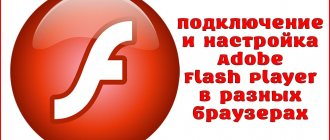Have you installed a new version of Adobe Flash Player, but it's buggy? Lost sound in the browser? Has your Youtube video started to slow down? Or does it even ask you to update the flash player, even though you just installed it? This happens sometimes. In this case, you need to reinstall Flash Player. That is, remove it and then install a new one. In most cases this will solve the problem.
What to do if deleting the flash player did not help? Then the last option remains. You will need to install a special utility to completely remove Adobe Flash Player from your computer. But first things first.
How to reinstall Flash Player?
It is very easy to remove Adobe Flash Player from your computer. For this:
- Go to Start – Control Panel – Programs and Features (or you can open “My Computer” and select “Uninstall or change a program”).
- A new window will open, displaying all installed programs on your PC or laptop.
- Select the desired line and click the “Delete” button.
- Ready.
Please note: in the screenshot above there are 2 flash players at once. The first (ActiveX) is for IE, and NPAPI is for other browsers (Mozilla, Opera, Yandex). If you have the same picture, then you need to delete both versions.
A separate plugin is installed for Chrome, and it is not displayed here.
This is the standard procedure for removing Adobe Flash Player. After that, install the new version again and everything should work: sound, video, games in the browser.
If this does not help, then you need to reinstall the flash player using the utility.
You need to know this: How to hide files and folders in Windows?
Uninstallation
Adobe Creative Cloud is a cross-platform application, without which it is impossible to install, update or synchronize any of the related programs from the Adobe developer. Without it, it is impossible to update the font or download the library, so the manufacturer does not recommend simply deleting this software from your computer.
This should be done only as a last resort, for example, when critical errors occur in the program that prevent you from installing or updating a particular component, including Cloud itself. In such situations, you must follow the instructions for removing program elements from your PC.
Note! Error code 2 is the most common among users. Its essence is that when trying to access the program, the system displays a message to the user that it could not be updated. The only solution here is to remove the application from your computer.
The uninstallation process itself will depend on the type of OS.
How to completely remove Flash Player?
The standard removal procedure leaves traces on the Windows system. To completely remove this plugin from your computer, you must use the Flash Player Uninstall utility from Adobe developers, designed specifically for such cases (link).
You run it and follow the program instructions - it will do everything itself.
The only caveat: before you remove the old version of Adobe Flash Player, you need to exit all browsers.
When the removal of the flash player is successfully completed, there are still a few simple steps left to complete. After all, the Adobe Flash Player Uninstaller utility leaves a couple of extra folders.
To remove them manually:
- Press Win + R.
- Copy to a new window C:\Windows\system32\Macromed\Flash.
- This folder will open where you need to delete the remaining files.
Repeat the same procedure for folders:
- C:\Windows\SysWOW64\Macromed\Flash
- %appdata%\Macromedia\Flash Player
- %appdata%\Adobe\Flash Player
Instead of Win + R, you can open any folder and copy all 4 items one by one into the top line for the address. Perhaps it will be easier and more convenient for you.
If a folder is missing, just skip it. If the files do not want to be deleted, restart your PC or laptop and try again. Or use the Unlocker program (if available).
This is how Flash Player is completely removed. You can make sure that you did everything correctly by opening this link. Click on “Check Now” and read the message.
And finally, it’s worth noting about the flash player in Chrome.
This is interesting: How to change the hard drive letter?
Windows tools
Open the Start menu > Control Panel
At the top right, switch the viewing mode - “Category” and click on the “Uninstall a program” link in the “Programs” section
There are two versions of flash player:
- Adobe Flash Player 15 Plugin - for all browsers except Internet Explorer and Google Chrome
- Adobe Flash Player 15 ActiveX - Internet Explorer only
The number 15 in the player name indicates the version of Adobe Flash Player.
It is advisable to uninstall both versions and reinstall them if necessary.
Left-click on Adobe Flash Player, highlighting it, and click the “Delete” button
The Adobe Flash Player Uninstaller will launch. Click the “DELETE” button
If we have open browsers or other applications that use Flash, the program will ask you to close them. Closing
After closing, the program should correctly remove Adobe Flash Player from our computer.
Click “DONE”
The version of Adobe Flash Player for Internet Explorer is also removed in the same way.
It remains a mystery to me why, when a program is correctly uninstalled according to all the rules and without failures, “spare parts” remain from the uninstalled program. Adobe Flash Player is no exception. “Spare parts” from it remain in the following folders:
C:\Windows\system32\Macromed\Flash
C:\Windows\SysWOW64\Macromed\Flash
%appdata%\Adobe\Flash Player
%appdata%\Macromedia\Flash Player
Copy the first address. Open Explorer and paste the copied path into the address field
We delete the contents of the opened folder.
In the same way we delete all files from other places.
Reboot the computer and check.
Go to the page https://helpx.adobe.com/ru/flash-player.html with a browser other than Google Chrome and click “Check now”
If you see a picture like the one below, it means we have uninstalled Adobe Flash Player.
Why do you need to access the above page from a browser other than Google Chrome? Because the flash player is built into Google Chrome and cannot be removed this way. Therefore, Google Chrome, even after uninstallation, will show that Adobe Flash Player is installed and running.
How to remove an outdated Flash Player plugin in Chrome?
Chrome already has built-in Flash Player. And you won’t be able to remove it using this method. It comes in the form of a plugin, so you can disable it by typing chrome://plugins in the address bar.
If there are certain problems (no sound or video is slow), try updating it manually. To do this, enter chrome://components in the address bar, find the flash player and click the “Check for updates” button.
If it doesn't help, reinstall the browser. But before that, I recommend reading the following article: How to save bookmarks when reinstalling Google Chrome?
That's all. Now you know how to properly remove Adobe Flash Player on a laptop or PC. And in two different ways. Next, all that remains is to install Flash Player, after which video, audio and games in the browser should be played in normal mode (without glitches or slowdowns).
What is adobe flash player
When we visit various sites on the Internet, we see different content on them: music, games, videos.
To play each of the files, our browser is forced to use third-party modules because its own resources are not enough for this. In simple terms , Adobe Flash is software that allows our browser to play media files on websites . For example, video in formats: MP4, SWF, FLV and F4V or audio in formats: MP3, FLAC, OGG, WAV and other media files.
Don't try to turn on the player, it's a picture.
That is, by integrating flash player, we simplify the task of installing separate players for each format . This makes life much easier for the average user and in most cases will completely satisfy their requirements. However, not everything is so smooth; the flash player has some disadvantages that may make you think about the need to install it.
- Flash content loads your computer. If you open the site where the video is posted and start playback, and then open the task manager, you can see how much the browser’s resource consumption has increased. This can be critical for weak or old computers;
- Frequent application crashes. While using the resource, unexpected failures occur, which can lead to the complete closure of the program, and therefore loss of time opening and loading the necessary sites;
- Vulnerability to viruses. The most compelling reason not to use the player is the presence of a large number of vulnerabilities in it, which attackers try to take advantage of and “infect” your device through them;
- Loss of relevance. A couple of years ago it was difficult to imagine a video or banner in html5 format, but now it is a reality. To play such files, you no longer need a player, and every day there are more videos in such formats on the Internet.
The above reasons force developers of popular browsers such as Google Chrome, Opera and Mozilla Firefox to refuse to use the Adobe player in further updates of their programs.
Why do you need Adobe Flash Player?
If the plugin is missing or outdated, then instead of some blocks on the site we see an empty gray rectangle, sometimes accompanied by a message about the problem. For example, yesterday I bought a train ticket on the Russian Railways website and received a message that “Firefox did not allow the outdated Adobe Flash plugin to launch on https://rzd.ru”:
Accordingly, instead of a site logo made using Flash technology, I was shown a gray rectangle. If you do not have the Adobe Flash plugin or have an old version of it, then similar problems will await you with some embedded videos, online games and website controls made using this technology.
Since Flash is no longer a rarity these days, you cannot do without a module that ensures its operation in browsers.
This is interesting: How to combine tables in the Word text editor
All this can be solved by simply installing a special plugin developed by Adobe, in my example by updating it.
How to determine if Adobe Flash Player is out of date
Your use of an outdated version of Flash Player will be signaled by sites that actively use this plugin. Some sites will directly inform you that the plugin is deprecated.
Also, obsolescence can be indicated by a message from a site about the complete absence of a plugin.
There is a way at any time you can view the version of the application and compare it with that on the official page https://get.adobe.com/ru/flashplayer/. To do this, you will need to open the program on your computer:
Next you will need to go to the update tab to view the module version.
Now you can compare the version of the installed module with the version of the program on the official Adobe website.
If the program version and the version on the official website match, everything is fine. Otherwise, you will need to update Flash Player.
Configuring automatic updating of Adobe Flash Player
The easiest way to update your application in a timely manner is to set up auto-update. To do this, you will need to open Flash Player installed on your computer.
Go to the “Updates” tab, “Change update settings” item.
After this, you need to allow the program to install updates.
In rare cases, automatic updating may not work correctly, in which case you will need to update the program manually.
How to completely remove Flash Player from your computer?
In this case, if we want to remove Flash Player completely, then we cannot do it with standard Windows tools alone, so to remove the plugin from the computer we will use the Revo Uninstaller program, which will not only remove the program from the computer, but also all files, folders and entries in the registry, which, as a rule, still remain in the system.
1.
Launch Revo Uninstaller. Please pay special attention to the fact that this program should only be run under an administrator account.
2.
In the program window, on the
“Uninstaller”
, a list of installed programs will be displayed, among which is Adobe Flash Player (in our case, there are two versions for different browsers - Opera and Mozilla Firefox).
Right-click on Adobe Flash Player and select “Uninstall”
.
3.
Before the program begins uninstalling Flash Player, it will create a Windows restore point, which will allow you to roll back the system if, after completely removing Flash Player from your computer, you encounter problems with the system.
4.
Once the point is successfully created, Revo Uninstaller will launch the built-in Flash Player uninstaller. Use it to complete the program removal procedure.
5.
Once Flash Player removal is complete, return to the Revo Uninstaller program window. Now the program will need to conduct a scan, which will check the system for the presence of remaining files. We recommend you about
or
“Advanced”
scanning mode so that the program checks the system more thoroughly.
6.
The program will begin the scanning procedure, which should not take much time. Once the scan is completed, the program will display the remaining registry entries on the screen.
Please note that in the program, highlight only those registry entries that are highlighted in bold. Anything that you doubt should not be deleted again, as it can disrupt the operation of the system.
Once you have selected all the keys that relate to Flash Player, click on the “Delete”
, and then select the
Next
.
7.
Next, the program will display the remaining files and folders on the computer.
Click on the "Select All"
, and then select
"Delete"
.
To complete the procedure, click on the “Finish”
.
This completes the uninstallation using the Flash Player removal utility. Just in case, we recommend restarting your computer.
Hello readers of the blog of the ComService company (Naberezhnye Chelny)! Today we will figure out how to remove Adobe Flash Player. This can be done in two ways: remove the Flash Player as a regular program in Windows and clean the remaining files, or download the Adobe Flash Player removal utility from the ADOBE website, use it and also clean the files. Below we will consider both options.
Article structure











